|
|
|
Sort Order |
|
|
|
Items / Page
|
|
|
|
|
|
|
| Srl | Item |
| 1 |
ID:
160874
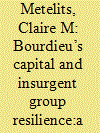

|
|
|
|
|
| Summary/Abstract |
The conflict between the rebel group, the Polisario Front, and the Kingdom of Morocco is nearing its 43rd year. Though under-reported, the conflict itself garners attention for the resilience – some would say tenacity – of the ethnically Sahrawi Polisario Front. Despite shifting regional and international politics and the nearly 150,000 Sahrawi refugees waiting in nearby Algerian camps, the rebel group has survived. What explains its resilience? This article uses Bourdieu’s ‘forms of capital’ to understand the Polisario Front’s persistence. Based on field research in Algeria, Western Sahara, and the United States, it finds that social, cultural, symbolic, and economic capital may provide an explanation.
|
|
|
|
|
|
|
|
|
|
|
|
|
|
|
|
| 2 |
ID:
160872
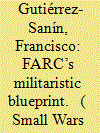

|
|
|
|
|
| Summary/Abstract |
This article intends to explain the outstanding sequence of success and failure exhibited by the FARC, the main Colombian guerrilla since the 1980s. It claims that such sequence is unintelligible unless the adoption by the FARC of a militaristic organizational blueprint at its 1982 7th Conference is taken into account. By building itself like an army, the FARC could boost its combat capacity, maintain its structural integrity, and develop powerful mechanisms that held the whole structure together. At the same time, the militarization of the FARC also entailed significant risks and costs like political isolation and high personnel turnover. After describing the militaristic blueprint, the article compares the FARC with other irregular forces that operated in the Colombian context – a comparison which is important to understand the specificity of the FARC trajectory, as well as the benefits and costs involved in it. The analysis highlights the critical role of organizational dimensions in the explanation of civil war outcomes, and suggests that at least for some problems organizational dynamics should be observed at a low level of granularity.
|
|
|
|
|
|
|
|
|
|
|
|
|
|
|
|
| 3 |
ID:
160875
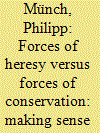

|
|
|
|
|
| Summary/Abstract |
Ethnicity and ideology are frequently used to determine whether an armed group is hostile or friendly vis-à-vis the state. By contrast, I argue that the social structure of insurgent movements holds more explanatory power for their respective positions than ethnicity or ideology. To illustrate this, I apply Pierre Bourdieu’s concept of a contest between forces of ‘conservation’ and forces of ‘heresy’ to the current Afghanistan war. I demonstrate that the social structure of the Taleban renders them prone to ‘heresy’, while the formerly second biggest insurgent group, Gulbuddin Hekmatyar’s party, has rather been an impeded force of ‘conservation.’
|
|
|
|
|
|
|
|
|
|
|
|
|
|
|
|
| 4 |
ID:
160879
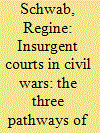

|
|
|
|
|
| Summary/Abstract |
As part of research on the meso-foundations of conflict, the field of ‘rebel governance’ examines political institutions that regulate the affairs of civilians in wartime as well as their relations with armed actors. Judicial institutions play an important role in this and research has shown that they are widespread among both historical and current insurgencies. However, usually these bodies have been analysed in the context of one hegemonic faction like the Tamil Tigers in Sri Lanka and the Afghan Taliban. What is missing so far is an analysis of different pathways of (trans)formation of rebel courts. As exemplified by the three case studies of judicial institutions in Eastern Ghouta, Idlib and Aleppo, these are shaped by the distribution of power between ‘same-side’ groups, yielding unipolar, bipolar, or multipolar constellations. The analysis is located on the meso or movement level of insurgent social structures, complementing research on the micro and macro levels.
|
|
|
|
|
|
|
|
|
|
|
|
|
|
|
|
| 5 |
ID:
160878
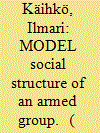

|
|
|
|
|
| Summary/Abstract |
This article investigates the Movement for Democracy in Liberia (MODEL) through a revised Weberian framework that focuses on legitimacy and offers a thick description of the different phases of this armed group. The article argues that the key to fostering cohesion is the harmonization of the micro, meso, and macro levels. This proved a difficult undertaking for the MODEL. Not only did the MODEL lack material resources but it also relied on different and evolving kinds of legitimacy on these levels. With its sources of legitimacy exhausted after the war, the MODEL ceased to exist.
|
|
|
|
|
|
|
|
|
|
|
|
|
|
|
|
| 6 |
ID:
160877
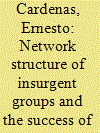

|
|
|
|
|
| Summary/Abstract |
We argue that organizational structure of insurgent organizations influences the prospects for success in a disarmament, demobilization, and reintegration process (DDR). In essence, we argue that more cohesive, tighter networks have higher levels of supervision and control on its military units and increase the probability of successful DDR processes. In order to evaluate our hypotheses, we use the theory of networks to map and characterize the network structure of the United Self-Defense Forces of Colombia (AUC) and the Revolutionary Armed Forces of Colombia (FARC). Our results suggest that armed military units grouped in smaller and more isolated components on the network remilitarize with higher probability with respect to other units on the network. Also, we find that military units with high degree of centrality on the network play an important role for the risk of conflict recurrence and success in a DDR process.
|
|
|
|
|
|
|
|
|
|
|
|
|
|
|
|
| 7 |
ID:
160871
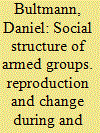

|
|
|
|
|
| Summary/Abstract |
Current research on civil wars and conflict increasingly turns to the inner structure and functioning of state and non-state armed groups and their impact on aspects such as violent practice, internal cohesion and the dissolution of these groups during the conversion to peace. The first aim of this introduction is to set out the theme of this Special Issue on the social structure of armed groups and previous research within the field. The second aim is to introduce the contributions within the Special Issue, alongside possible trajectories of future research on the ‘meso-foundations’ of civil war and conflict.
|
|
|
|
|
|
|
|
|
|
|
|
|
|
|
|
| 8 |
ID:
160876
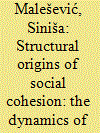

|
|
|
|
|
| Summary/Abstract |
This article explores the dynamics of social cohesion on the frontline. It attempts to show how micro-level solidarities largely depend on macro level organisational processes. I argue that frontline social cohesion is often the product of social development linked with the organisational structure. This general argument is applied to the case studies of two armed forces involved in the 1991–1995 Wars of Yugoslav Succession – the Croatian Army (HV) and the Bosnian Serb Army (VRS). Drawing on in-depth interviews with the former combatants I show how HV social cohesion played an important role in winning the war and how these networks of micro-level solidarity were shaped by long term organisational development.
|
|
|
|
|
|
|
|
|
|
|
|
|
|
|
|
| 9 |
ID:
160873


|
|
|
|
|
| Summary/Abstract |
Our paper investigates the political trajectories of armed actors in Mali since 2012, using recent theoretical advances on alliance formation and collapse in civil wars. Our paper establishes an analytically productive distinction between levels of wartime cleavages and factors shaping groups’ trajectories. Strategic alliances, we argue, emerge from anticipated benefits on the national political scene as well as in the local political economy. The two sets of considerations do not necessarily converge. This dual logic is studied through the cases of two armed groups, both siding with the government after originally aligning with jihadi and separatist coalitions respectively.
|
|
|
|
|
|
|
|
|
|
|
|
|
|
|
|
|
|
|
|
|